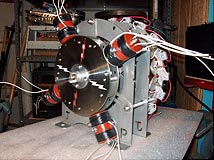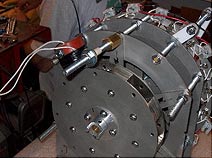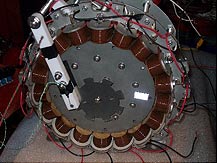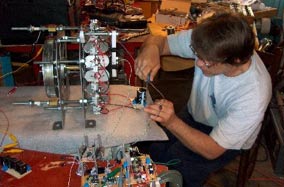By Bill Costantino June 6, 2008
In April of this year, The Orion Project launched a research effort focused on Pulsed Motor / Generator (PMG) technology. We believe a PMG may ultimately be able to self-power and provide enough electrical power to cover all the requirements for an average home or small business. Our goal is to develop a working proof-of-concept prototype to undeniably demonstrate this possibility. We are presently working with a team of researchers who have studied and experimented with these devices for many years. They are now underway developing and testing a one-half scale PMG to prove the principle. Once this has been achieved, we will scale it up to determine if the proper power requirements can be met.

The two primary researchers bring years of expertise to this challenge. Their specific names and locations are being withheld in order to insure their privacy, safety, and security. Mr. Q brings considerable skill in electro-mechanical system design. Mr. P brings 30 years of electrical engineering experience in custom circuit design. The week of May 19-23, P traveled from his home to conduct the first round of development work with Q at his laboratory in the midwest. Four series of tests were conducted during this time, consuming over 100 man-hours of focused effort.
Prior to their joint work together, each inventor made the utmost preparations in advance. Q designed the electro-mechanical system from the very beginning to have all of its parts made to a certain standard so that many different configurations could quickly and efficiently be arranged. P likewise brought electronic components that were modular in nature to allow the same plug & play testing.
The object of these initial tests was to simply get the control electronics successfully working with the electro-mechanical generator that Q already had built. After a few iterations of adjustment, they were able to get the motor spinning a few hundred RPM by tuning the electronics. Several other configurations of electronics and driver coils were tested. Overall, the initial Linderman style rotor (one without magnets) never achieved sufficient RPM to hold promise for any meaningful power generation.

The next round of tests was to replace the Linderman style rotor with rotor containing magnets. Electronic controls were adjusted accordingly. This configuration was tested using single and multiple driver coils. While they were able to achieve rotation in all configurations, RPMs were still too low to be able to deliver meaningful power output. Motor speed was limited due to magnetic interference effects.
To avoid this magnetic interference, the team switched to another ingenious arrangement in hopes of eliminating this back-drag. They were successful and soon achieved 1,500 RPM while using only a fraction of the full system capabilities – very encouraging! They systematically activated more of the system with corresponding refinement of the drive electronics.

They soon optimized the above configuration to a nominal RPM in preparation to take some power measurements. Next, they disconnected the supply lead from the power controller, expecting the rotor to naturally coast to a stop, essentially un-plugged from its power source. Quite unexpectedly, however, the rotor began to accelerate rapidly – disconnected from the power supply lead! It was clear that an intense power surge was somehow generated within the system. In his 30 years experience, P had never seen this type of behavior and is currently at a loss to explain it. The surge was powerful enough to damage key components of the electrical controls, and thus testing came to a halt. While it is too early to make any definitive claims about the source of this power surge, the effect is of great interest and clearly warrants further investigation.
After regrouping, the team attempted to duplicate the above effect using other types of electrical components. They encountered problems, however, and achieved inconsistent results in reproducing the acceleration phenomenon. They were, however, able to achieve a new high speed of almost 2500 RPM of the rotor – again encouraging progress. The motor is capable of much higher speeds once we are able to further refine the driver circuits.

“P” customizing electrical control circuits during the first round of PMG development work.
Already the team has agreed on the next experimental design. The singular focus is to recreate the anomalous event but with more precise observation, measurement, and stabilization. P is contacting the manufacturers of the electrical components in search of any known explanation for the anomalous behavior. The next scheduled week for testing is June 23-27.
Stay Tuned!
Donate Today and Be a Part of this Exciting Opportunity!
We appreciate your support and interest and invite you to continue spreading the word of our efforts to others and provide whatever additional tax deductible contributions you can. We will share our progress on this and other projects as they develop.